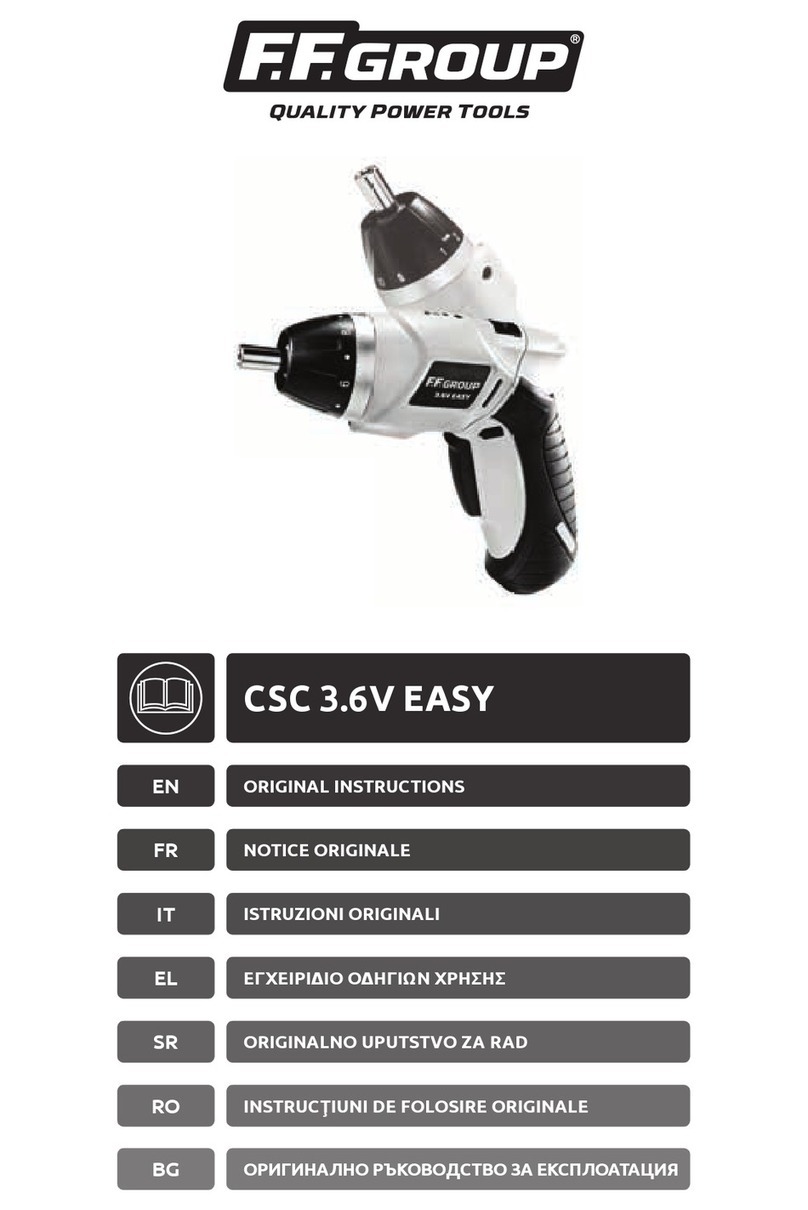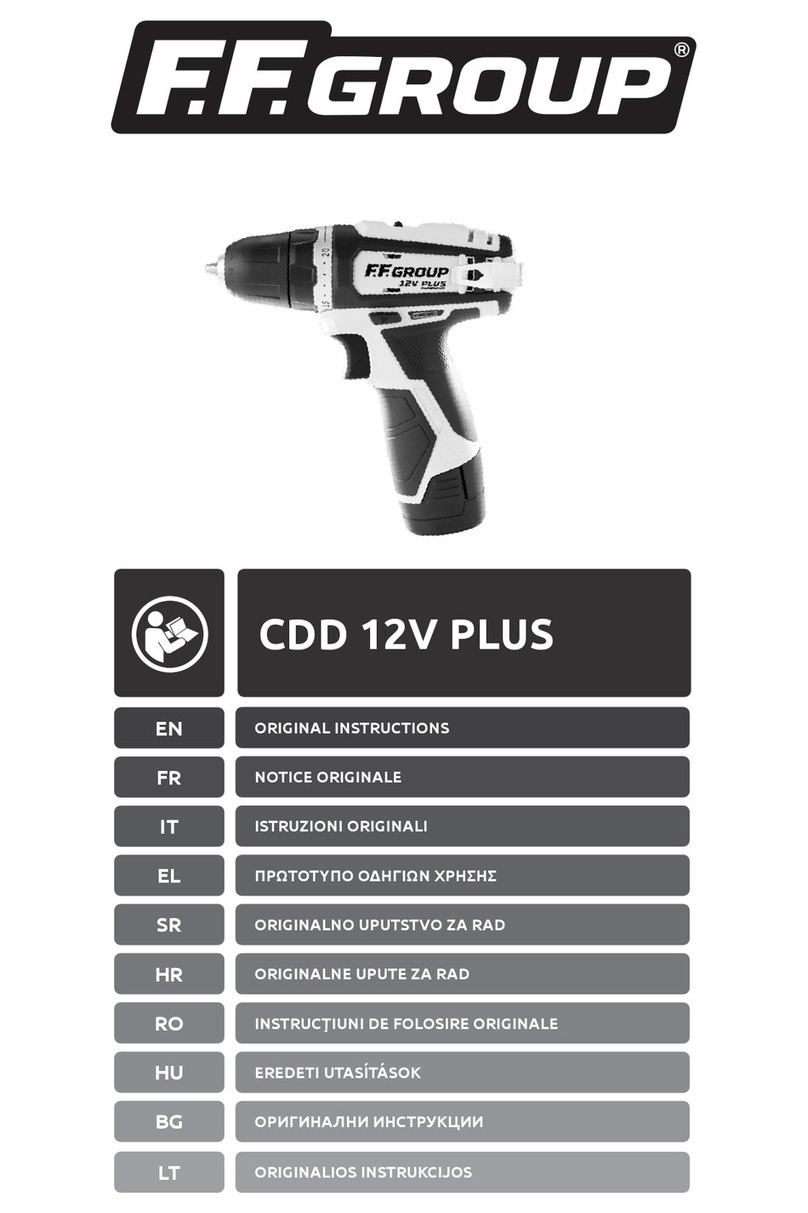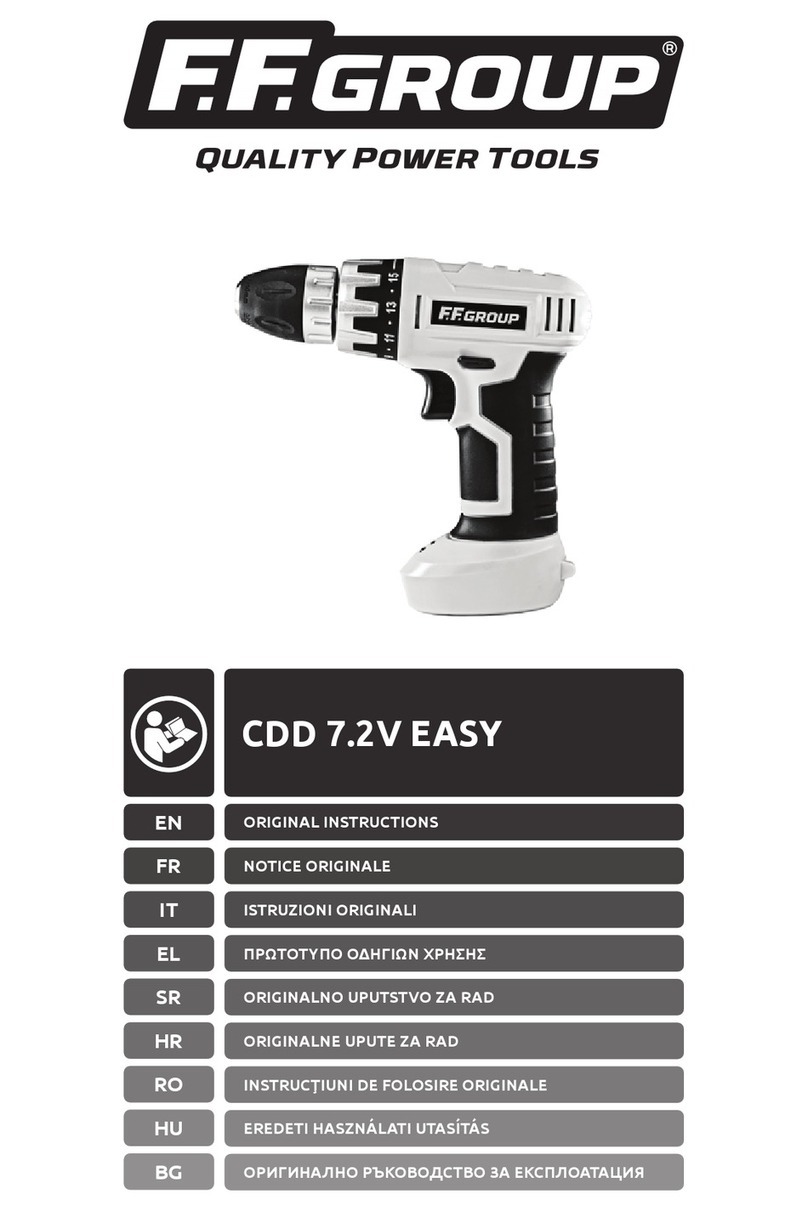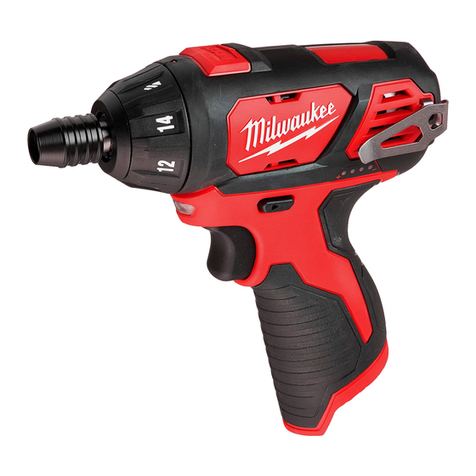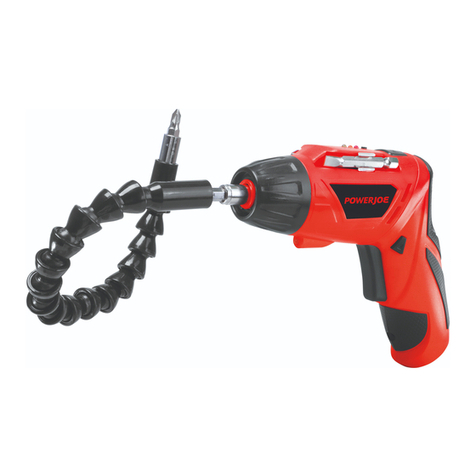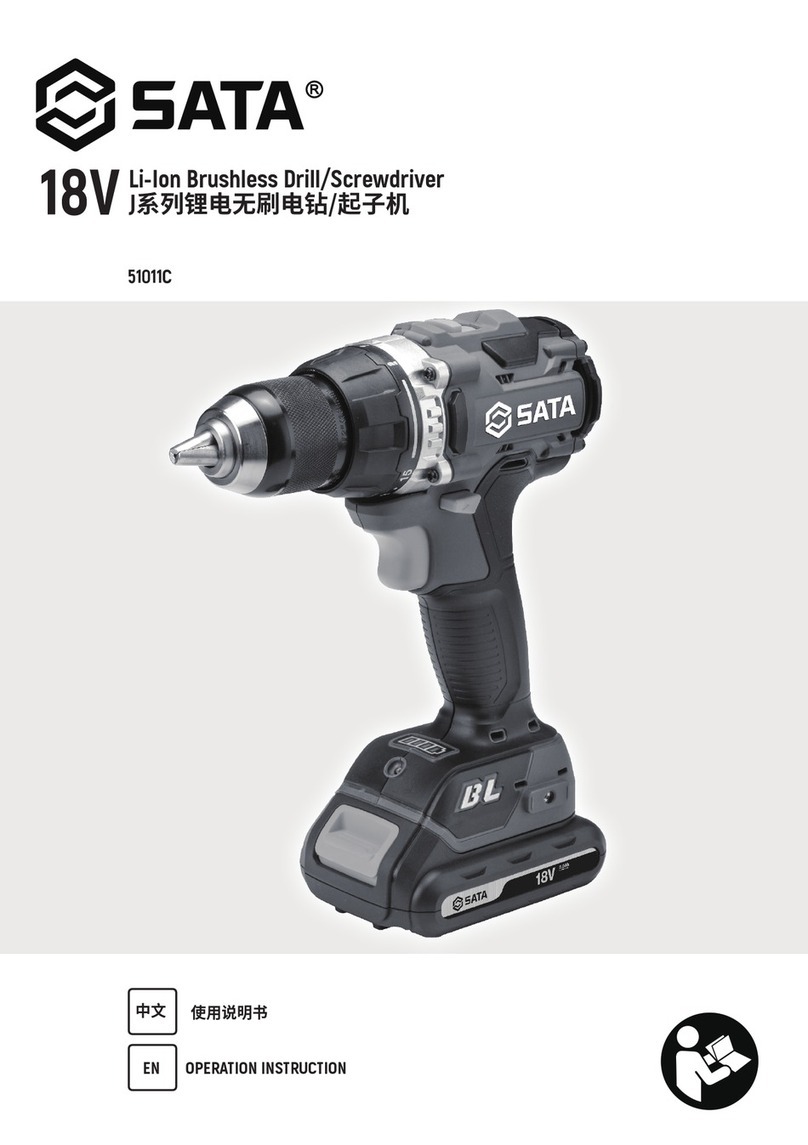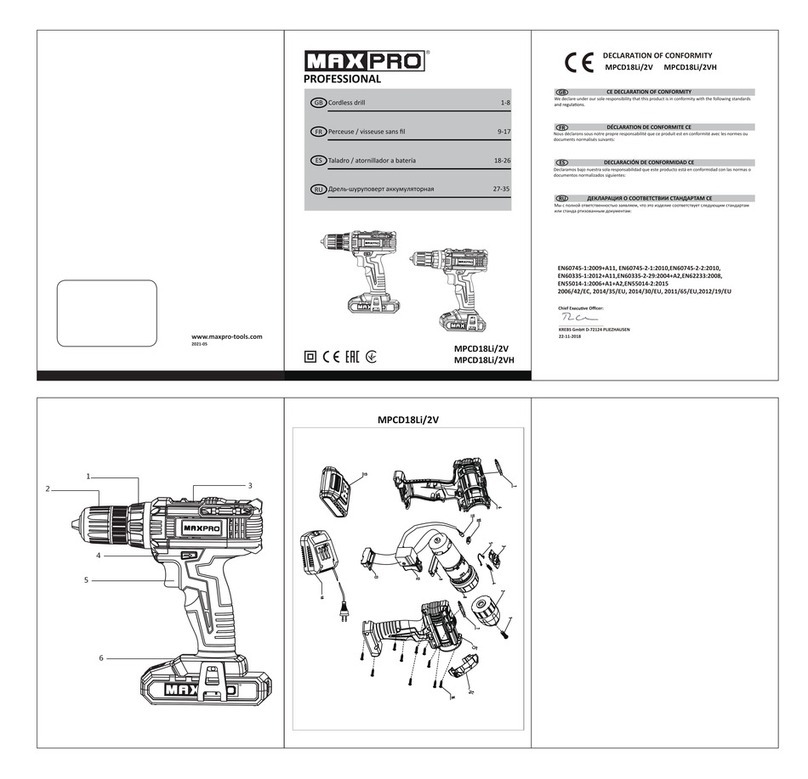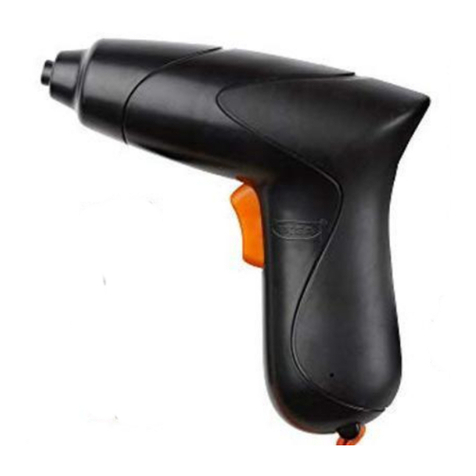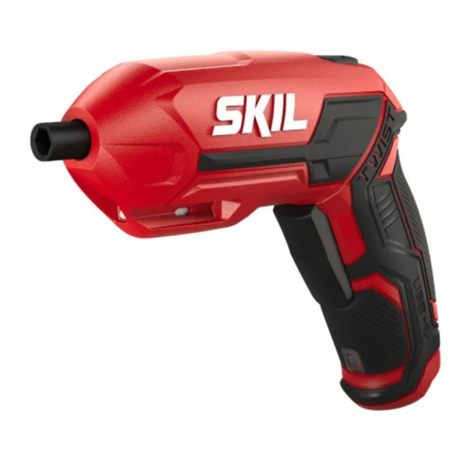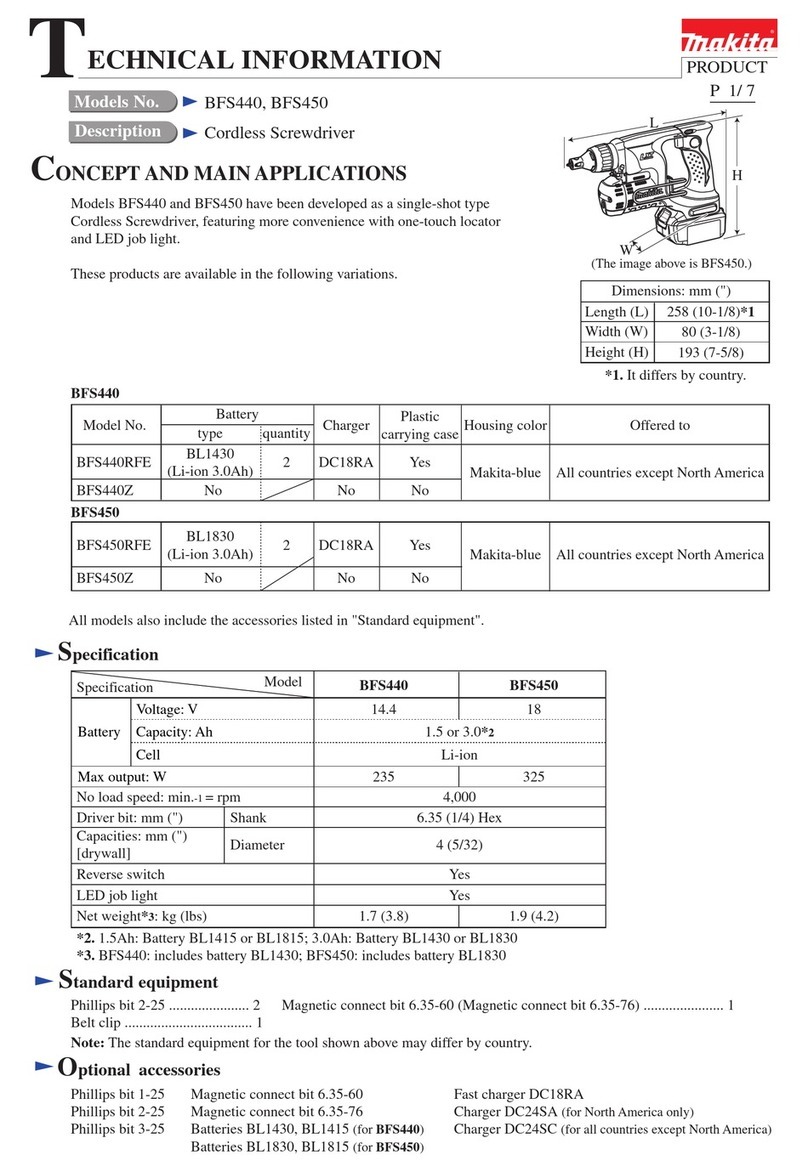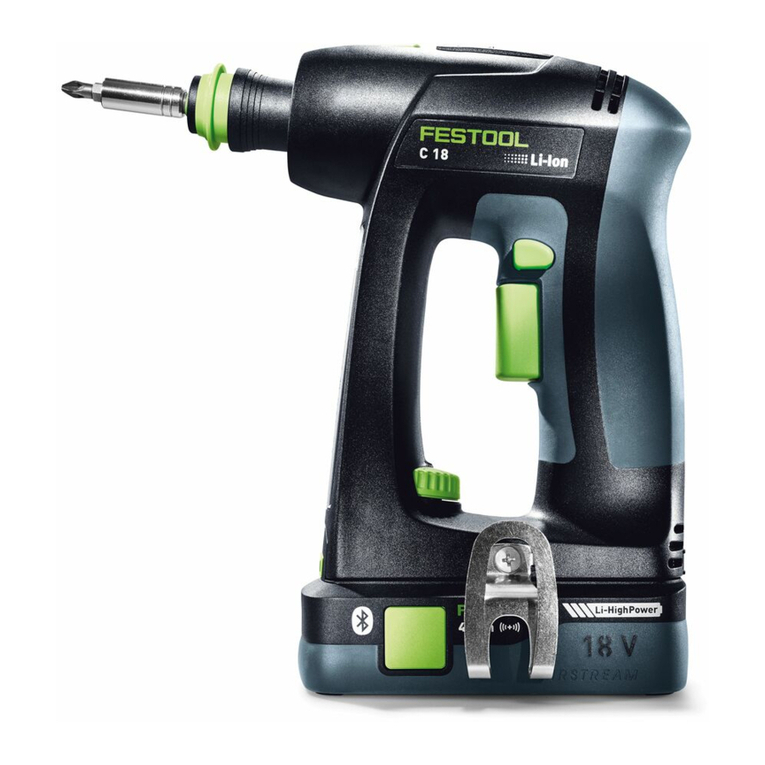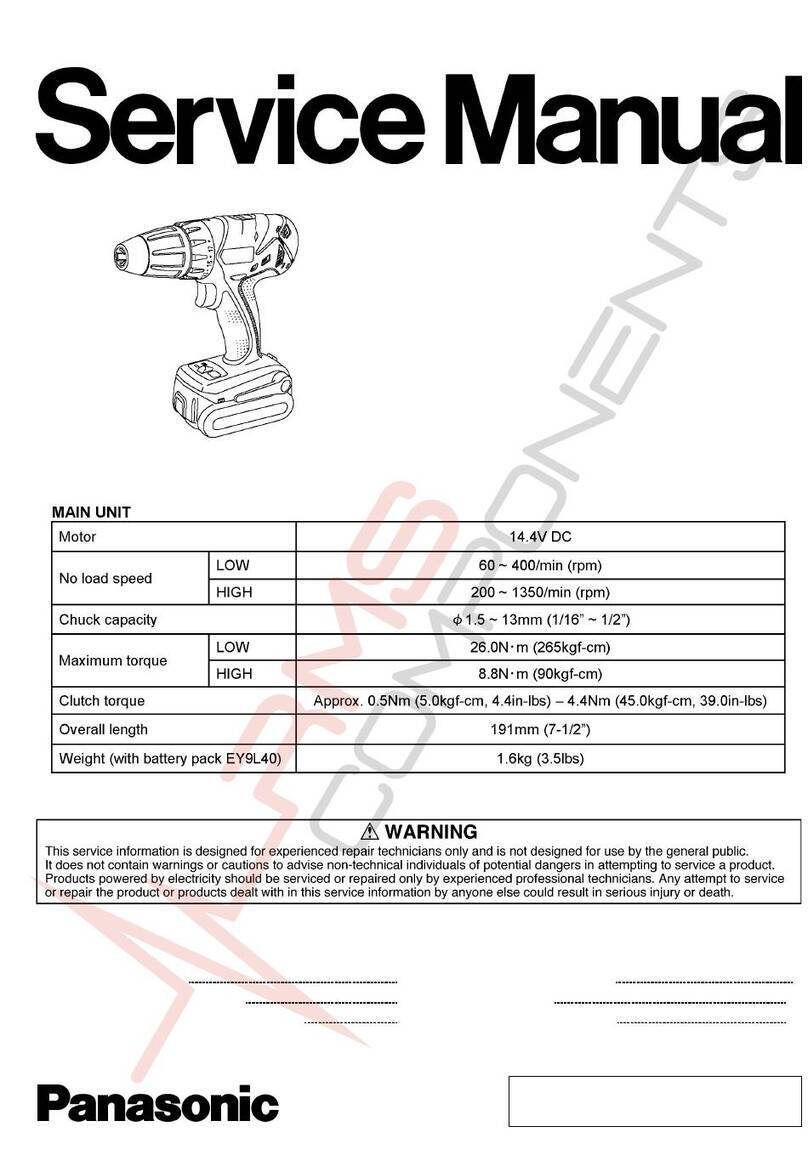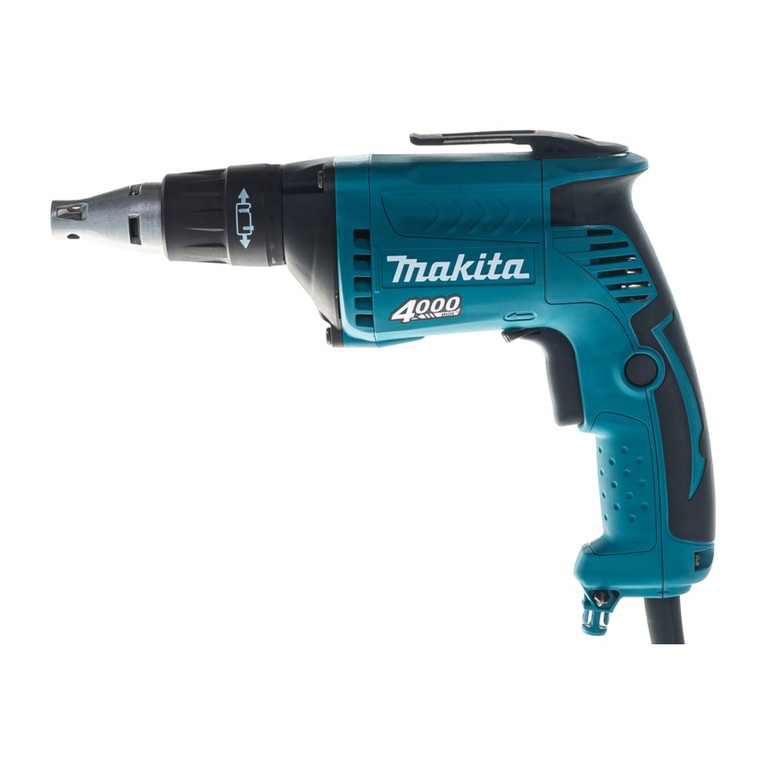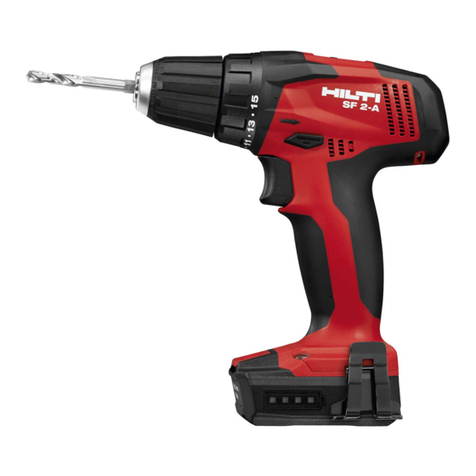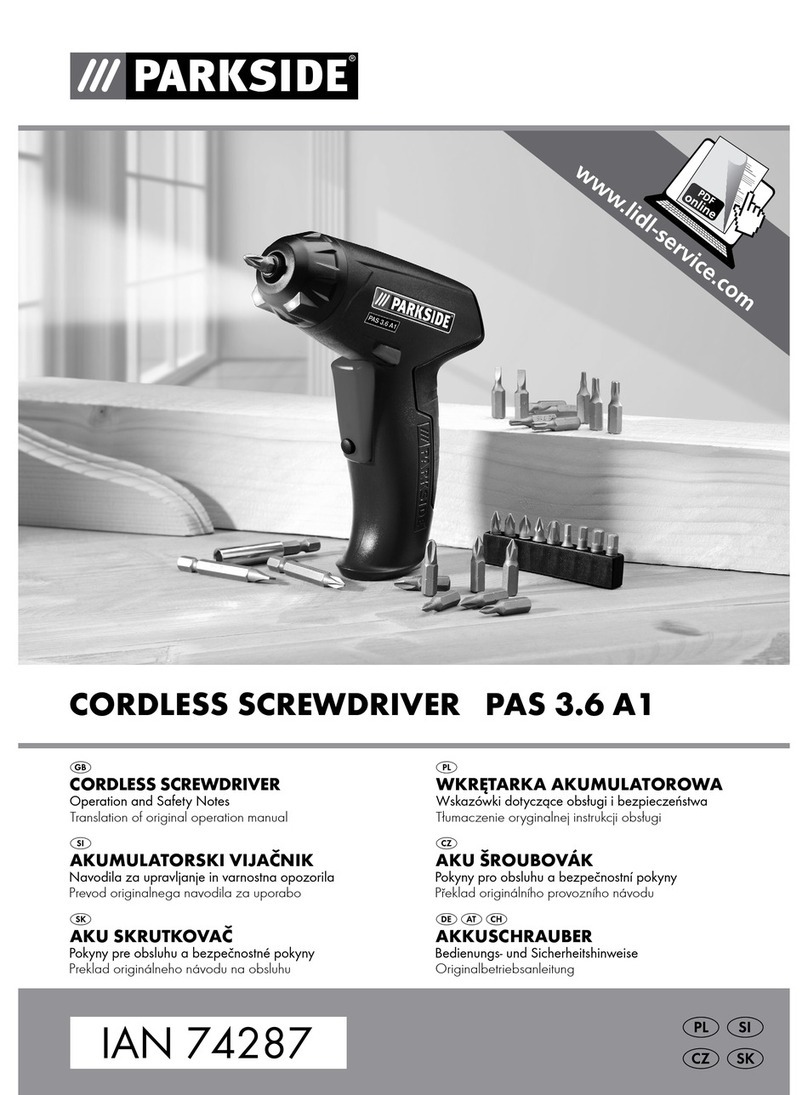F.F. Group CDD/35 20V PRO User manual

CDD/35 20V PRO
CDD/40 20V PRO
ORIGINAL INSTRUCTIONS
ISTRUZIONI ORIGINALI
IT
ORIGINALNO UPUTSTVO ZA RAD
SR
RO
HR
HU
BG

2CDD/35 20V PRO | CDD/40 20V PRO
04
06
10
IT 16
21
SR 27
HR 32
RO 37
HU 43
BG 48
54

3
www.ffgroup-tools.com
CDD/35 20V PRO | CDD/40 20V PRO
6
10
3
3
2
2
5
4
4
1
1
6
6
7
7
8
8
11
11
9
9
41315
41314
41624 5

4CDD/35 20V PRO | CDD/40 20V PRO
ΕΝ
To reduce the risk of
injury, the user must
read and under-
stand this manual
before using this
product
Wear eye
protection.
Damage to hear-
hearing protec-
tion is not worn.
Damage to
-
not worn
Wear
Li-ion battery
must be recycled
or disposed of
properly
FR
les risques de bles-
sures, l’utilisateur
doit lire et assimiler
d’utiliser ce produit.
Porter des
lunettes de
protection.
Dommages à
l’audition si une
protection audi-
pas portée.
Dommages
aux poumons
si un masque
antipoussière
pas porté
Porter des
gants de
protection
La batterie Li-ion
doit être recyclée
ou éliminée
correctement
IT
Per ridurre il rischio
di infortuni, prima
di usare il prodotto,
-
re il manuale
Indossare
protezioni
per gli occhi.
Indossare prote-
zioni per gli occhi.
Danni all’udito,
se non si
indossano pro-
tettori auricolari
Indossare
guanti
La batteria Li-ion
smaltita corretta-
mente
EL
-
-
-
-
SR
neophodno je da
Nosite zaštitu
ako se ne koristi
efikasna zaštita
sluha.
ako se ne koristi
efikasna maska
za zaštitu od
prašine
Nosite zaštit-
Litijum-jonska
baterija mora
da se reciklira ili
HR
opasnost od ozlje-
de, korisnik mora
Nosite zaštitu
ako se ne nosi
za sluh.
ako ne koristite
zaštitnu masku.
Nosite
zaštitne
Litij ionska
baterija mora
se reciklirati ili
RO
Pentru a reduce ris-
-
utiliza acest produs.
-
urechi.
Deteriorarea
Afectarea
-
prafului
Bateria li-ion
HU
A sérülések elkerü-
és értse meg ezt az
elkezdi használni ezt
a terméket
-
A hallása káro-
sodhat, ha nem
álarcot
-
A li-ion akkumulá-
kell újrahasz-
hulladékként
kezelni
BG
-
-
-
-
-
-

5
www.ffgroup-tools.com
CDD/35 20V PRO | CDD/40 20V PRO
ΕΝ
Protect the
battery against
Protect the
battery against
temperatures
only. Do not
expose to rain
Double insu-
lation
Important,
danger, warning,
or caution
Conforms to
standards
FR
Protéger la pile
de la chaleur et
du feu
Protéger
la pile des
températures
supérieures à
45° C
À usage
intérieur
uniquement. Ne
pas exposer à la
pluie
Double insu-
lation
Important,
-
tissement ou
prudence
Conforme aux
normes de sécuri-
té concernées
IT
Proteggere
la batteria da
calore e fuoco
Proteggere
la batteria da
temperature
superiori a
45°C
-
te per uso in
ambienti interni.
Non esporre a
pioggia
Doppio isola-
mento
Importante,
attenzione
Conformi alle
pertinenti norme
sulla sicurezza
EL
-
-
45oC
-
-
-
SR
bateriju od
bateriju od
temperatura
Samo za
prostoru.
Nemojte izlagati
kiši.
izolacija
upozorenje ili
oprez
standardima za
bezbednost
HR
-
riju od topline
bateriju od
temperatura
Samo za korište-
-
nom prostoru.
Ne izlagati kiši
izolacija
upozorenje ili
oprez
-
tnim standardima
sigurnosti
RO
-
focului
-
temperaturilor
de peste 45°C
Doar pentru
-
Important, peri-
-
HU
-
akkumulátort a
45 °C-nál maga-
-
Csak beltéri
használatra. Ne
Dupla szige-
telés
-
tetés
-
kozó biztonsági
BG

| English6CDD/35 20V PRO | CDD/40 20V PRO
-
ings and instructions may result in electric
The term “power tool” in
the warnings refers to your mains-operated
(corded) power tool or battery-operated
(cordless) power tool.
Cluttered or
-
Power tools create sparks
which may ignite the dust or fumes.
-
Distractions can cause you to
lose control.
-
risk of electric shock.
There is an increased risk of electric
shock if your body is earthed or grounded.
-
Water entering a power tool will increase the
risk of electric shock.
-
Damaged or entangled cords increase the risk
of electric shock.
cord suitable for outdoor use reduces the risk of elec-
tric shock.
electric shock.
A
moment of inattention while operating power tools
may result in serious personal injury.
as dust mask, non-skid safety shoes, hard hat, or
hearing protection used for appropriate conditions
will reduce personal injuries.
Carrying power tools
-
A wrench or a key left
attached to a rotating part of the power tool may
result in personal injury.
-
This enables better control of
the power tool in unexpected situations.
Loose clothes, jewelery
dust collection can reduce dust-related hazards.
The correct
power tool will do the job better and safer at the
rate for which it was designed.
Any power tool that cannot be
controlled with the switch is dangerous and must be
repaired.
-
-
power tool accidentally.
-
Power tools are dangerous in the hands
of untrained users.
Many accidents
are caused by poorly maintained power tools.
Properly
maintained cutting tools with sharp cutting edges
are less likely to bind and are easier to control.
-
-
sult in a hazardous situation.
A charger that is suitable for one type of
another battery pack.

www.ffgroup-tools.com
English | 7CDD/35 20V PRO | CDD/40 20V PRO
Shorting the battery terminals together may cause
-
Liquid ejected
from the battery may cause irritation or burns.
This will ensure that the safety of the power
tool is maintained.
before you start working.
insert jams. Be prepared for high reaction torque that
can cause kickback. The tool insert jams when:
It becomes wedged in the workpiece
-
ing at least the highest no-load speed of the tool.
(including children) with reduced physical, sensory or
mental capabilities, or lack of experience and knowl-
person responsible for their safety.
Secure the workpiece (a workpiece clamped with
by hand).
Hold power tool by insulated gripping surfaces, when
performing an operation where the cutting accessory
or fastener may contact hidden wiring or its own cord
wire may make exposed metal parts of the power tool
call the local utility company for assistance (contact
damaging a gas line can result in an explosion; pene-
trating a water pipe will cause property damage or an
electrical shock).
Always wait until the machine has come to a com-
plete stop before placing it down. The tool insert can
Dust from material such as paint containing lead,
some wood species, minerals and metal may be harm-
ful (contact with or inhalation of the dust may cause
operator or bystanders); wear a dust mask and work
as oak and beech dust) especially in conjunction with
a. Before charging, read the instructions.
b.
c. Do not charge non-rechargeable batteries.
a. -
ance before it is scrapped.
b. The appliance must be disconnected from the
c. The battery is to be disposed of safely.
d. Do not use non-rechargeable batteries.
e. Do not crush, open or burn the battery. Exposure
to potentially harmful materials may occur.
f. 2dry chemical extinguisher.
g. Do not expose to high temperatures >45°C. Cells
may degrade at high temperatures.
h. The battery must be charged by a constant cur-
i. Charge battery regularly in conditions between
for this battery.
j. -
ommended limits of 10°C to 30°C.
k. Do not use battery if it has been stored at 5°C or
less. Allow it to "normalise" at room temperature
l.
for recycling separately to the product, which is
-
Make sure the power supply information on the ma-
chine’s rating plate are compatible with the power
supply you intend to connect it to.
This appliance is Class II* and is designed for connec-
tion to a power supply matching that detailed on the
the instruction supplied with the extension lead.
*Double insulated: This product requires no
earth connection as supplementary insulation
is applied to the basic insulation to protect
the basic insulation.
As a substance under normal conditions of use it is not
-
-
Composition of lithium-manganese, lithium-cobalt and
-
ous liquid).

| English8CDD/35 20V PRO | CDD/40 20V PRO
Hazardous Decomposition: None during normal oper-
and carbon monoxide may be released.
PRODUCT
drill bits, intended for drilling holes in wood, plastic,
metal etc. It is intended for domestic and light com-
mercial use only. Any other application is considered
misuse.
41314 41624 41315
Wood mm 25 35
Mild Steel mm 10 13
Maximum
Torque Nm 35 40
Per Minute
(no load)
min-1
0-1.250
0-1250
Chuck
Capacity
inch
Weight (drill
& battery) kg 1,5 1,7
Sound pres-
dB(A) 84 84
Sound pow-
dB(A) 95 95
-
dB 3 3
60745-1
ah21,55 1,55
21,5 1,5
ah20,59 0,59
21,5 1,5
Type Li-Ion
20 20
Ah 2,0 2,0
Charging
time (80%) min 40 40
Charging
time (100%) min 50 50
100-240 100-240
-
quency Hz
-
er Input W 80 80
Output
22 22
Output
Current
A 3,0 3,0
1. Chuck with auto-lock system
2. Torque setting ring
3.
4. Soft grip handle
5. Battery pack release button
6. Battery pack (x2 for 41315, 41624)
7. LED working light
8. Trigger and electronic speed control
9. Two speed selector
10.Battery Charger
11.Belt Clip
Slide the battery into the handle until it engages. To
and pull the battery out of the handle.
green LEDs.
When the battery is fully charged all three LEDs light up.
>100%
Yellow LED on >67%
>30%
The charger is equipped with a LED charging indi-
cator lamp. During charging, the indicator light will
light up red. After completion of charging,the light

www.ffgroup-tools.com
English | 9CDD/35 20V PRO | CDD/40 20V PRO
turns green.
Connect the charger to a suitable mains socket. The
green charging light comes on
Slide the battery onto the charger, the red charging
light comes on
The charger may become warm and buzz slightly
during charging. This is normal and does not indicate
a fault.
-
collar anti-clockwise to open
the chuck.
Insert the drill bit,making
sure it is centred in the
chuck.
Tighten the chuck by
turning clockwise. Pull
on the bit to ensure it
Open the chuck by
rotating the chuck
the drill bit.
To switch on the
1. or
2. Change the direction of rotation only when the
machine is not in operation!
To stop drilling release the trigger.
-
Operating the machine with a low speed
for a long time will increase the risk that the motor
motor cool down regularly (Stop using the machine
for 15 minutes).
setting ring to the
desired setting. The
torque setting will
help you regulate the
bit. This will help to
The two speed selector
controls the speed
allows slower drilling
with more torque,while
second gear is suitable
when less torque but higher speed is required.
Slide the selector
gear
Slide the selector
backward to select second gear
The tool has an LED light to illuminate the work area
-
while the trigger switch is depressed.
Set the torque collar to lowest setting and tighten the
-
remaining screws.
Ensure that the torque adjustment collar is set to
the most suitable setting, if in doubt start with a low
setting and gradually increase the setting until the
most suitable position is found.
pressure to the trigger initially.
Only increase the speed when full control can be
maintained.
-
ger and just smaller than the shank diameter of the
The pilot hole will act as a guide for the screw and
When screws are positioned close to an edge of the
-
ting of the wood.
the screw head so that it does not protrude.
and try a slightly larger or longer hole but remem-
ber there must be enough material for the screw to
grip! If restarting a screw in a hole, locate and make
-
lubricant such as soap; liquid soap is usually best.
bit turning out of the screw head. The screw head
When attempting to drill a large diameter hole, it is

CDD/35 20V PRO | CDD/40 20V PRO| Français10
sometimes best to start with a smaller drill bit then
work up to the required size.
Many accidents occur because of un-
foreseeable situations. Please pay attention that
drilling-out a small hole may cause the drill bit to jam
in the hole.
holes to allow the swarf to be ejected from the hole.
-
bit should enter at right angles to the work. If the
angle is changed during drilling, this could cause the
-
ing injury.
the item being drilled.
Don’t force the drill, let it work at its own pace.
holes, use auger bits or spade bits for wood drilling.
Set the tool to the drill mode.
speed as it bites into the wood.
When drilling through holes, place a block of wood
-
tered edges on the back of the hole.
metal drilling.
the hole using a centre punch.
working on.
Always clamp sheet metal. Support thin metal with
waste. Machine, accessories and packaging
recycling. The plastic components are labeled
for categorized recycling.
This product is warranted in accordance with the le-
-
handling will be excluded from the guarantee. In
case of a claim, please send the machine, completely
electric power tools.
Ne pas
donner lieu à un choc électrique, un incendie
Le terme «outil»
-
nant sur batterie (sans cordon d’alimentation).
-
Les zones en désordre ou sombres sont pro-
pices aux accidents.
-
Les outils électriques produisent des
les fumées.
Les dis-
l’outil.
Des fiches non modifiées et des socles adap-
tés réduiront le risque de choc électrique.
-
corps est relié à la terre.
La pénétration d’eau à l’inté-
rieur d’un outil augmentera le risque de choc élec-
trique.
-
Les cordons endommagés ou emmêlés aug-
mentent le risque de choc électrique.
L’utilisation d’un cordon adapté à l’utilisation exté-
rieure réduit le risque de choc électrique.
-
choc électrique.

CDD/35 20V PRO | CDD/40 20V PRO
www.ffgroup-tools.com
Français | 11
-
-
De nombreux acci-
dents sont dus à des outils mal entretenus.
Des outils destinés à couper correcte-
-
chantes sont moins susceptibles de bloquer et sont
L’utilisation de l’outil pour des opérations
des situations dangereuses.
-
approprié à un type spécifique d’accumulateur peut
engendrer un risque d’incendie lorsqu’il est utilisé
-
ner des blessures et des risques d’incendie.
-
-
-
Au cas où le liquide ren-
trerait dans les yeux, consultez en plus un médecin. Le
-
-
Cela assurera que la sécurité
de l’outil est maintenue.
-
la tension indiquée sur la plaquette signalétique du
chargeur.
Arrêtez immédiatement l’appareil électrique lorsque
importants causant un contrecoup. L’outil se bloque
lorsque:
l’appareil électrique est surchargé ou
-
ment d’inattention en cours d’utilisation d’un outil
Les équi-
pements de sécurité tels que les masques contre
les poussières, les chaussures de sécurité antidéra-
pantes, les casques ou les protections acoustiques
utilisés pour les conditions appropriées réduiront les
blessures des personnes.
-
Porter les outils
en ayant le doigt sur l’interrupteur ou brancher des
outils dont l’interrupteur est en position marche est
source d’accidents.
-
tournante de l’outil peut donner lieu à des blessures
de personnes.
Cela permet un
-
tendues.
-
-
-
collecteurs de poussière peut réduire les risques dus
aux poussières.
L’outil adapté réalisera mieux le
il a été construit.
Tout outil qui ne peut pas être commandé par
l’interrupteur est dangereux et il faut le faire réparer.
De telles mesures de sé-
accidentel de l’outil.
-
Les outils sont

CDD/35 20V PRO | CDD/40 20V PRO| Français12
de l’outil.
des personnes (y compris des enfants) dont les capacités
physiques, sensorielles ou mentales sont réduites, ou
manquant d’expérience ou de connaissances, excepté si
par une personne responsable de leur sécurité.
le chargeur.
que si elle était tenue à la main).
Tenez l’outil par les surfaces de préhension isolées, lors
de la réalisation d’une opération au cours de laquelle
également mettre sous tension les parties métalliques
sur l’opérateur)
présence de conduites électriques ou bien s’adresser
une décharge électrique; le fait d’endommager une
celui-ci soit complètement à l’arrêt. L’outil risque de se
l’outil électroportatif.
La poussière de matériaux, tels que la peinture conte-
nant du plomb, certaines espèces de bois, certains
-
respiratoires chez l’opérateur ou des personnes se
-
lorsqu’il est possible d’en connecter un.
étant cancérigènes (tels que la poussière de chêne ou
-
tifs de traitement du bois; portez un masque antipous-
lorsqu’il est possible d’en connecter un.
a.
b. À usage intérieur. Ne pas exposer à la pluie.
c. Ne pas charger des batteries non rechargeables.
a.
d’être mise au rebut.
b. L’appareil doit être débranché de l’alimentation
lors du retrait de la batterie.
c. La batterie doit être éliminée en toute sécurité.
d. Ne pas utiliser de batteries non rechargeables.
e. -
sition à des matériaux potentiellement dangereux
peut se produire.
f. En cas d’incendie, utiliser un extincteur à poudre
chimique C02.
g.
-
h. -
teur à tension et intensité constantes.
i. Charger la batterie régulièrement entre 5° C et 45°
j.
les limites recommandées de 10° C à 30° C.
k. Ne pas utiliser la batterie si elle a été stockée à une
température inférieure ou égale à 5° C. Laisser re-
changement.
l.
batterie pour la recycler séparément du produit, qui
-
ments électriques et électroniques. Isoler les bornes
court-circuit, incendie ou explosion.
indiquées sur la plaque signalétique de la machine,
-
tation correspondant à celle indiquée sur l’étiquette,
-
*Double isolation: Ce produit ne nécessite au-
cune mise à la terre car l’isolation principale est
équipée d’une isolation supplémentaire, pour
protéger contre les électrocutions en cas de dé-
faillance de l’isolation principale.
En tant que substance utilisée normalement, il n’est
pas considéré être nocif pour la santé. En cas de dé-
Composition de lithium-manganèse, de lithium-cobalt
organique (liquide non aqueux).
Décomposition dangereuse: Aucune en utilisations
-
de forets, destinés à percer des trous dans le bois,
le plastique, le métal, etc. Elle n’est destinée qu’à
un usage domestique et commercial léger. Toute
autre utilisation est considérée inadéquate.

CDD/35 20V PRO | CDD/40 20V PRO
www.ffgroup-tools.com
Français | 13
41314 41624 41315
Bois mm 25 35
Acier doux mm 10 13
Couple
maximal Nm 35 40
par minute (à
min-1
0-1.250
0-1250
Mandrin
inch
Poids
(perceuse et
batterie)
kg 1,5 1,7
l’appareil sont
pression
acoustique
dB(A) 84 84
d’intensité
acoustique
dB(A) 95 95
Incertitude
dB 3 3
-
ah21,55 1,55
21,5 1,5
ah20,59 0,59
21,5 1,5
Type Li-Ion
Tension
nominale 20 20
Ampérage Ah 2,0 2,0
Temps de
charge(80%) min 40 40
Temps de
charge
(100%)
min 50 50
Tension
nominale 100-240 100-240
nominale Hz
Puissance
nominale W 80 80
Tension CC
nominale 22 22
Tension
Ampérage A 3,0 3,0
1.
2. Bague de réglage du couple
3.
4. Poignée souple
5. Bouton de déblocage de la batterie
6. Batterie (x 2 pour 41315, 41624)
7.
8. -
9.
10.Chargeur de la batterie
11.Accroche-ceinture
AVANT TOUT UTILISATION
qu’elle s’enclenche. Pour la retirer, appuyer sur le bou-
ton jaune, et retirer la batterie de la poignée.
Lorsque la batterie est complètement chargée, les
trois LED s’allument.
>100%
LED jaune allumé >67%
LED rouge allumée >30%
-
gement de la batterie. Lorsque la batterie est en train
Brancher le chargeur sur une prise de courant. Le
lorsque la batterie se recharge. Il n’y a rien ici d’anor-

CDD/35 20V PRO | CDD/40 20V PRO| Français14
mal; ce n’est pas l’indice d’une panne.
-
le collier du mandrin dans
aiguilles d’une montre,
Installer le foret
en s’assurant qu’il
soit centré dans le
mandrin.
des aiguilles d’une montre. Tirer sur le foret pour
s’assurer qu’il soit bien tenu par le mandrin.
en faisant tourner
le collier du man-
foret.
-
Indiqué sur le bouton de marche
1. ou
2.
machine est arrêtée!
-
-
tesse pendant une longue période, augmente le
-
ter d’utiliser la machine pendant 15 minutes).
Tourner la bague de
réglage du couple
pour la mettre sur la
graduation désirée.
Le réglage du couple
la puissance d’en-
lent en fonction d’un couple plus important, tandis
premier rapport
second rapport
-
-
Installer le bon embout.
la graduation la plus appropriée. En cas de doute,
commencer sur une petite graduation, puis aug-
menter petit à petit jusqu’à ce que le réglage le plus
-
trou, légèrement plus long et un petit peu plus petit
fendre le bois.
-
cer un trou légèrement plus grand ou plus long,
-
à enfoncer (comme lors de l’utilisation de bois très
durs), essayer d’uti-
notamment du sa-
est généralement le
meilleur.

CDD/35 20V PRO | CDD/40 20V PRO
www.ffgroup-tools.com
Français | 15
-
ment sur l’outil pour
ne sorte de la tête
être endommagée, et l’enfoncer ou l’extraire peut
diamètre, il est parfois préférable de commencer
par un foret plus petit, puis de continuer jusqu’à la
taille requise.
De nombreux accidents ar-
-
trou, peut amener le foret à se coincer dans le trou.
-
peaux d’être éjectés hors du trou.
Si le foret se coince, éteindre immédiatement la per-
foret.
Essayer de retirer le foret et faisant fonctionner la
montre.
-
rement dans la pièce. Si l’angle change pendant le
-
quer des blessures.
Appuyer moins lorsque l’outil est sur le point de tra-
Ne pas forcer sur la perceuse, la laisser percer à son
propre rythme.
Pour percer au mieux de gros trous, utiliser des
mèches à bois plates pour percer le bois.
que le foret ne glisse du point de départ. Augmen-
dans le bois.
-
chiqueter les bords ou d’éclater le bois à l’arrière du
trou.
-
-
que le foret ne glisse du point de départ.
déformer.
éliminer comme des déchets. L’outil, les acces-
-
ronnement. Les composants en plastique sont
Tout dommage attribuable à une usure normale, à une
surcharge ou à une utilisation incorrecte de l’outil sera
un Centre de réparation des outils électriques.

CDD/35 20V PRO | CDD/40 20V PRO| Italiano16
-
-
trà creare il pericolo di scosse elettriche, in-
-
Il termine «elettroutensi-
riferisce ad utensili elettrici alimentati dalla
rete (con linea di allacciamento) ed ad uten-
sili elettrici alimentati a batteria (senza linea
di allacciamento).
Il disordine oppure zone della po-
causa di incidenti.
-
-
-
distrazioni potranno comportare la perdita del
controllo sull’ elettroutensile
-
-
-
Le spine non modificate e le prese adatte allo
scopo riducono il rischio di scosse elettriche.
-
Sussiste un maggior ri-
schio di scosse elettriche nel momento in cui il cor-
po è messo a massa.
-
La penetrazione dell’acqua in
un elettroutensile aumenta il rischio di una scossa
elettrica.
-
-
-
scosse elettriche.
-
-
ITALIANO l’impiego all’esterno riduce il rischio d’insorgenza
di scosse elettriche.
L’uso di un interrutto-
re di sicurezza riduce il rischio di una scossa elettrica.
-
-
-
-
di distrazione durante l’uso dell’elettroutensile
Indossan-
do abbigliamento di protezione personale come la
-
ne acustica a seconda del tipo e dell’applicazione
dell’elettroutensile, si riduce il rischio di incidenti.
-
-
Tenendo il dito sopra l’interruttore
mentre si trasporta l’elettroutensile oppure col-
legandolo all’alimentazione di corrente con l’in-
-
cura di mettersi in posizione sicura e di mantene-
re l’equilibrio in ogni situazione. In questo modo
è possibile controllare meglio l’elettroutensile in
caso di situazioni inaspettate.
-
-
L’utilizzo di
modo migliore e più sicuro nell’ambito della sua po-
tenza di prestazione.
-
-

CDD/35 20V PRO | CDD/40 20V PRO
www.ffgroup-tools.com
Italiano | 17
-
-
-
-
-
-
da persone non dotate di sufficiente esperienza.
-
da elettro tensili la cui manutenzione è stata effet-
tuata poco accuratamente.
attenzione e con taglienti affilati s’inceppano meno
frequentemente e sono più facili da condurre.
-
-
consentiti potrà dar luogo a situazioni di pericolo.
LATORI
-
-
determinato tipo di accumulatore, sussiste pericolo
di incendio, se utilizzato con un accumulatore di tipo
-
-
genza a lesioni e comportare il rischio d’incendi.
-
-
re potrà dare origine a bruciature o ad incendi.
-
-
Il liquido fuoriuscito dall’accumulato-
re potrà causare irritazioni cutanee o bruciature.
-
In tale
dell’ elettroutensile.
-
Controllare che la tensione dell’alimentazione sia la
stessa di quella indicata sulla targhetta del caricatore.
Spegnere immediatamente l’elettroutensile quando
l’utensile accessorio si blocca. Aspettarsi sempre alti
-
traccolpo. L’utensile accessorio si blocca quando:
-
zione.
corrisponda almeno al massimo dei numeri di giri
dell’utensile.
-
sensoriali e mentali o con scarsa esperienza e cono-
-
la loro sicurezza o siano state da essa istruite sull’utiliz-
il caricatore.
Tenere sempre ben saldo l’elettroutensile. Serrando
-
-
mane bloccato in posizione con maggiore sicurezza se
morsa e non tenendolo con la mano).
-
-
-
ne può mettere sotto tensione anche parti metalliche
dell’apparecchio, causando una scossa elettrica).
-
scoste, utilizzare adatte apparecchiature di ricerca op-
-
incendi e di scosse elettriche; danneggiando linee del
gas si può creare il pericolo di esplosioni; penetrando
-
elettrica).
Prima di posare l’elettroutensile, attendere sempre
-
cessorio può incepparsi e comportare la perdita di
controllo dell’elettroutensile.
-
bo, alcune specie di legno, minerali e metallo possono
-
sturbi respiratori all’operatore o ad altre persone pre-
-

CDD/35 20V PRO | CDD/40 20V PRO| Italiano18
LITIO
Come sostanza in condizioni normali di utilizzo non è
considerata un pericolo per la salute. In caso di perdi-
ta accidentale, è necessario attenersi alle misure per
d’acqua o scarichi.
Composizione di litio-manganese, litio-cobalto e sali di
acquoso).
Prodotti di decomposizione pericolosi: Nessuno in
condizioni normali di utilizzo. In caso di perforazio-
idrogeno e monossido di carbonio.
Questo trapano a batteria è progettato per essere
usato con un’ampia gamma di punte per foratura su
-
mente a un uso domestico e commerciale leggero.
Qualsiasi altra applicazione è considerata uso im-
proprio.
41314 41624 41315
Legno mm 25 35
Acciaio dolce mm 10 13
Coppia
massima Nm 35 40
min-1
0-1.250
0-1250
Capacità
mandrino
inch
Peso (trapa-
no e batteria) kg 1,5 1,7
-
-
ta normalmente a
pressione
acustica
dB(A) 84 84
potenza
sonora
dB(A) 95 95
Incertezza
della misura
dB 3 3
se è presente una presa di collegamento.
a. Prima di caricare la batteria, leggere le istruzioni.
b. Per uso in ambienti interni. Non esporre a pioggia.
c. Non ricaricare batterie non ricaricabili.
a. -
ria.
b. Scollegare l’apparecchio dalla rete elettrica prima di
c.
d. Non usare batterie non ricaricabili.
e. Non rompere, aprire o bruciare la batteria. Potrebbe
dannosi.
f. 2.
g. Non esporre a temperature >50°C. A temperature
h. -
te costante e tensione costante.
i.
comprese tra 5°C e 45°C con il caricabatteria speci-
j. -
tro i limiti consigliati da 10°C a 30°C.
k.
temperatura di 5°C o inferiore. Lasciarla "normaliz-
zare" a temperatura ambiente prima dell’uso o della
sostituzione.
l.
della batteria per uno smaltimento separato dal
apparecchiature elettriche ed elettroniche. Isolare i
-
sione.
Assicurarsi che le informazioni di alimentazione
della macchina siano compatibili con l’alimenta-
zione elettrica cui si intende collegarla. Questo
apparecchio è di Classe II* ed è progettato per es-
sere collegato a una rete elettrica corrispondente a
-
patibile con la spina in dotazione. Nel caso in cui sia
compatibile e garantita per questo apparecchio.
Seguire tutte le istruzioni fornite con la prolunga.
*Doppio isolamento: Questo prodotto non ri-
chiede messa a terra poiché all’isolamento di
base è stato applicato un isolamento supple-
mentare per fornire protezione da scarica elet-

CDD/35 20V PRO | CDD/40 20V PRO
www.ffgroup-tools.com
Italiano | 19
batteria dall’impugnatura.
-
pletamente.
-
Quando la batteria è del tutto carica si accendono
tutte e tre le luci.
>100%
Luce LED gialla accesa >67%
Luce LED rossa accesa >30%
Il caricabatteria è dotato di un indicatore lumino-
so LED di ricarica. Durante la ricarica, l’indicatore
emetterà una luce rossa. A ricarica terminata, la
Collegare il caricabatteria a una presa di corrente
-
derà la luce rossa di ricarica
Il caricabatteria potrebbe riscaldarsi ed emettere un
leggero ronzio durante la ricarica. Questo è normale
e non indica un guasto.
Per inserire una punta per
-
tatore, ruotare l’anello del
mandrino in senso antiorario
per aprire il mandrino.
Inserire la punta per tra-
pano, assicurandosi
che sia centrata nel
mandrino.
Serrare il mandrino
ruotandolo in senso
orario. Tirare la punta
per assicurarsi che sia
Aprire il mandrino
ruotando l’anello
del mandrino
punta.
-
ah21,55 1,55
21,5 1,5
ah20,59 0,59
21,5 1,5
Tipo Li-Ion
Tensione
nominale 20 20
Ah 2,0 2,0
Tempo di
ricarica (80%) min 40 40
Tempo di
ricarica
(100%)
min 50 50
Tensione
nominale 100-240 100-240
nominale Hz
Potenza
nominale
assorbita
W 80 80
C.C. nomina-
le Tensione
in uscita
22 22
C.C. nomina-
le Corrente
in uscita
A 3,0 3,0
1. Mandrino con sistema autobloccante
2. Anello di regolazione della coppia
3.
4. Impugnatura soft-grip
5. Pulsante di sgancio del pacco batteria
6. Batteria (x2 per i modelli 41315 e 41624)
7.
8. Pulsante interruttore e regolatore elettronico di
9.
10.Caricabatteria
11.Clip per cintura
-
mere il pulsante di sgancio della batteria ed estrarre la

CDD/35 20V PRO | CDD/40 20V PRO| Italiano20
-
Per arrestare l’apparecchio, rilasciare l’interruttore di
1.
o
2. Cambiare la direzione di rotazione solo quando
la macchina non è in funzionamento!
Per iniziare a forare, premere il pulsante interrut-
rilasciare il pulsante interruttore.
-
L’uso prolungato dell’apparecchio a
-
regolarmente il motore (smettere di usare l’appa-
recchio per 15 minuti).
-
golazione della coppia
desiderata. L’impo-
stazione della coppia
aiuterà a regolare la
-
re quando in uso con
-
trapano. Il primo rapporto consente una foratura più
lenta con una coppia maggiore, mentre il secondo
rapporto è indicato
quando si richiede una
coppia minore ma una
-
re il primo rapporto
indietro per seleziona-
re il secondo rapporto
-
LED si accenderà automaticamente quando il pulsante
interruttore è premuto.
Impostare l’anello della coppia al minimo e serrare la
-
-
Assicurarsi che la regolazione della coppia sia la più
appropriata, se in dubbio iniziare con una regolazio-
ne bassa e aumentare gradualmente la regolazione
-
plicando sul pulsante interruttore una pressione
minima.
-
tenere un controllo totale.
Si consiglia di eseguire prima un foro pilota, legger-
mente più lungo e con un diametro leggermente
da applicare.
stessa.
bordo del materiale, il foro pilota consentirà inoltre
-
-
-
liquido è solitamente migliore.
Quando si tenta di eseguire un foro di grande dia-
-
mensione richiesta.
-
che quando si esegue un foro piccolo la punta po-
trebbe rimanere incastrata nel foro.
profondi per consentire ai trucioli di essere espulsi
dal foro.
Se la punta si inceppa, spegnere immediatamente
-
pano.
Mantenere il trapano allineato con il foro. Idealmen-
This manual suits for next models
4
Table of contents
Languages:
Other F.F. Group Power Screwdriver manuals
